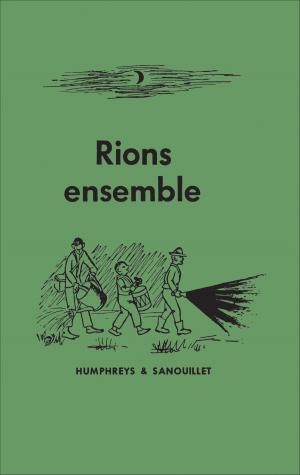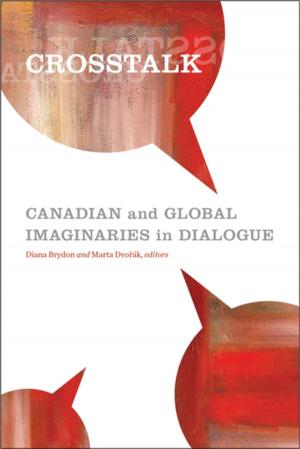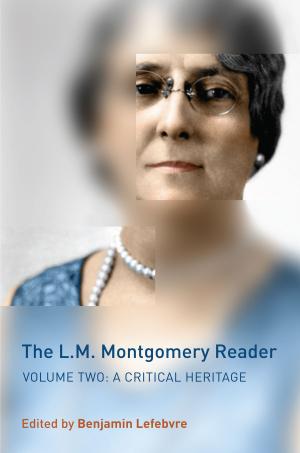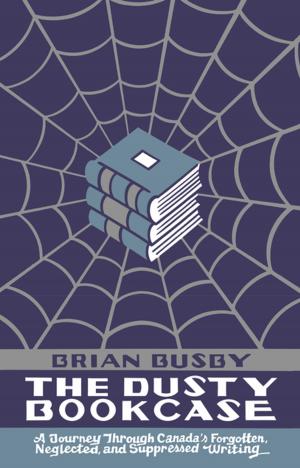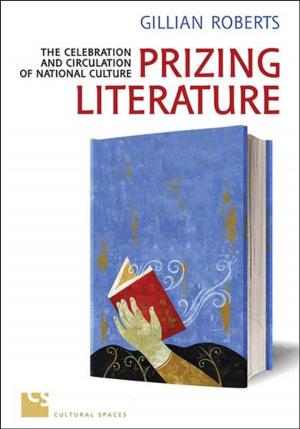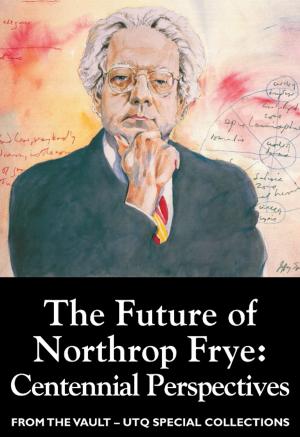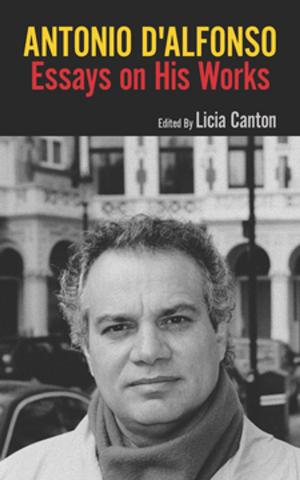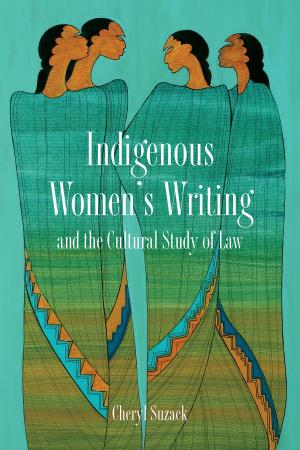Robertson Davies Reconsidered (From the Vault: UTQ Special Collections)
Fiction & Literature, Literary Theory & Criticism, Canadian| Author: | ISBN: | 9781442667822 | |
| Publisher: | University of Toronto Press, Journals Division | Publication: | November 1, 2011 |
| Imprint: | Language: | English |
| Author: | |
| ISBN: | 9781442667822 |
| Publisher: | University of Toronto Press, Journals Division |
| Publication: | November 1, 2011 |
| Imprint: | |
| Language: | English |
This volume is a collection of papers that had their origin in a symposium called ‘Reconsiderations of Robertson Davies,’ which took place at Massey College, University of Toronto. Davies helped found Massey and he served as its first master (1963–81). Prior to this role, Davies had (after an abortive career as an actor) been known to the Canadian public as a journalist, a witty and satiric columnist, a newspaper publisher, a successful playwright, an internationally acclaimed novelist, and later a librettist and author of ghost stories. This volume aims to reconsider Davies’ substantial legacy from the perspective of the nearly twenty years that have passed since his death, offering an opportunity to reassess his reputation and gain new perspectives on his work.
Critics have focused on Davies as a satirist and portraitist, locating his work in the context of a Canadian tradition of writers who capture the problems of claustrophobic community (think Stephen Leacock’s satiric humour and Alice Munro’s realist depictions of small towns). Others have noted Davies’ use of archetype and myth, seeing his fiction as an expression of the Frye-influenced interest in universal heroes and archetypal patterns that emerged in Canada in the 1960s. The critics who participated in the symposium’s reconsiderations, however, most often turned their attention to what seems to mediate between the local and the universal in Davies’ work: the arts, especially the theatrical.
Davies’ initial interest in theatre had an effect on his entire career, beginning with his feelings of failure as an actor, which led him to playwriting, and his failures as a playwright, which led him to embrace fiction (a fiction in which the theatre – and related spectacles, such as the magic act – is often prominent). The stage also taught Davies about the human capacity for self-invention. All who encountered him were aware of how much theatricality was a part of his life.
Sharon Reid’s discussion of melodrama as the kind of drama to which Davies found himself most drawn – a form that depends heavily on secrets and disclosure – reveals Davies as a writer who distinguished himself by his fervent commitment to artistic forms that would both ‘change and enlarge us.’ Reid points out that Davies’ fondness for melodrama carried over into his fiction, where melodramatic plots in his novels are one of the features that give them their Dickensian quality.
Robin Elliott’s consideration of music – like drama, both a structural element and a recurrent topic for Davies – reminds us that Davies was fascinated by that most melodramatic of all art forms: the opera – a mode of artistic expression that attracted him from his earliest days to the end of his life. A proficient melopoetic artist, weaving music and musicians into his literary works with consummate skill and artistry, Davies was also professionally active as a music critic and a librettist. Opera and other forms of music, along with drama, spectacle, and the visual arts, become an ambiance in which Davies’ main characters function.
Although Davies’ fiction can still be read as a record of life as it was once lived in Canada, this volume emphasizes the creation of other or new selves in times of change, allowing for a unique introduction between Davies’ work and his newer readers. The stable world from which Davies emerged has vanished, but the next generation of readers will find that world recorded in his narratives; they will also find that those narratives speak to their newly diverse, metropolitan, and flexible lives. Fables that tell of escape from communal and familial repression are simultaneously stories of how to create the necessary persona for a diverse culture. This volume provides insight on a Canadian literary icon for both fans of and strangers to Davies; a must read for individuals who understand the need to hide parts of their selves while revealing and dramatizing others.
Critics have focused on Davies as a satirist and portraitist, locating his work in the context of a Canadian tradition of writers who capture the problems of claustrophobic community (think Stephen Leacock’s satiric humour and Alice Munro’s realist depictions of small towns). Others have noted Davies’ use of archetype and myth, seeing his fiction as an expression of the Frye-influenced interest in universal heroes and archetypal patterns that emerged in Canada in the 1960s. The critics who participated in the symposium’s reconsiderations, however, most often turned their attention to what seems to mediate between the local and the universal in Davies’ work: the arts, especially the theatrical.
Davies’ initial interest in theatre had an effect on his entire career, beginning with his feelings of failure as an actor, which led him to playwriting, and his failures as a playwright, which led him to embrace fiction (a fiction in which the theatre – and related spectacles, such as the magic act – is often prominent). The stage also taught Davies about the human capacity for self-invention. All who encountered him were aware of how much theatricality was a part of his life.
Sharon Reid’s discussion of melodrama as the kind of drama to which Davies found himself most drawn – a form that depends heavily on secrets and disclosure – reveals Davies as a writer who distinguished himself by his fervent commitment to artistic forms that would both ‘change and enlarge us.’ Reid points out that Davies’ fondness for melodrama carried over into his fiction, where melodramatic plots in his novels are one of the features that give them their Dickensian quality.
Robin Elliott’s consideration of music – like drama, both a structural element and a recurrent topic for Davies – reminds us that Davies was fascinated by that most melodramatic of all art forms: the opera – a mode of artistic expression that attracted him from his earliest days to the end of his life. A proficient melopoetic artist, weaving music and musicians into his literary works with consummate skill and artistry, Davies was also professionally active as a music critic and a librettist. Opera and other forms of music, along with drama, spectacle, and the visual arts, become an ambiance in which Davies’ main characters function.
Although Davies’ fiction can still be read as a record of life as it was once lived in Canada, this volume emphasizes the creation of other or new selves in times of change, allowing for a unique introduction between Davies’ work and his newer readers. The stable world from which Davies emerged has vanished, but the next generation of readers will find that world recorded in his narratives; they will also find that those narratives speak to their newly diverse, metropolitan, and flexible lives. Fables that tell of escape from communal and familial repression are simultaneously stories of how to create the necessary persona for a diverse culture. This volume provides insight on a Canadian literary icon for both fans of and strangers to Davies; a must read for individuals who understand the need to hide parts of their selves while revealing and dramatizing others.
This volume is a collection of papers that had their origin in a symposium called ‘Reconsiderations of Robertson Davies,’ which took place at Massey College, University of Toronto. Davies helped found Massey and he served as its first master (1963–81). Prior to this role, Davies had (after an abortive career as an actor) been known to the Canadian public as a journalist, a witty and satiric columnist, a newspaper publisher, a successful playwright, an internationally acclaimed novelist, and later a librettist and author of ghost stories. This volume aims to reconsider Davies’ substantial legacy from the perspective of the nearly twenty years that have passed since his death, offering an opportunity to reassess his reputation and gain new perspectives on his work.
Critics have focused on Davies as a satirist and portraitist, locating his work in the context of a Canadian tradition of writers who capture the problems of claustrophobic community (think Stephen Leacock’s satiric humour and Alice Munro’s realist depictions of small towns). Others have noted Davies’ use of archetype and myth, seeing his fiction as an expression of the Frye-influenced interest in universal heroes and archetypal patterns that emerged in Canada in the 1960s. The critics who participated in the symposium’s reconsiderations, however, most often turned their attention to what seems to mediate between the local and the universal in Davies’ work: the arts, especially the theatrical.
Davies’ initial interest in theatre had an effect on his entire career, beginning with his feelings of failure as an actor, which led him to playwriting, and his failures as a playwright, which led him to embrace fiction (a fiction in which the theatre – and related spectacles, such as the magic act – is often prominent). The stage also taught Davies about the human capacity for self-invention. All who encountered him were aware of how much theatricality was a part of his life.
Sharon Reid’s discussion of melodrama as the kind of drama to which Davies found himself most drawn – a form that depends heavily on secrets and disclosure – reveals Davies as a writer who distinguished himself by his fervent commitment to artistic forms that would both ‘change and enlarge us.’ Reid points out that Davies’ fondness for melodrama carried over into his fiction, where melodramatic plots in his novels are one of the features that give them their Dickensian quality.
Robin Elliott’s consideration of music – like drama, both a structural element and a recurrent topic for Davies – reminds us that Davies was fascinated by that most melodramatic of all art forms: the opera – a mode of artistic expression that attracted him from his earliest days to the end of his life. A proficient melopoetic artist, weaving music and musicians into his literary works with consummate skill and artistry, Davies was also professionally active as a music critic and a librettist. Opera and other forms of music, along with drama, spectacle, and the visual arts, become an ambiance in which Davies’ main characters function.
Although Davies’ fiction can still be read as a record of life as it was once lived in Canada, this volume emphasizes the creation of other or new selves in times of change, allowing for a unique introduction between Davies’ work and his newer readers. The stable world from which Davies emerged has vanished, but the next generation of readers will find that world recorded in his narratives; they will also find that those narratives speak to their newly diverse, metropolitan, and flexible lives. Fables that tell of escape from communal and familial repression are simultaneously stories of how to create the necessary persona for a diverse culture. This volume provides insight on a Canadian literary icon for both fans of and strangers to Davies; a must read for individuals who understand the need to hide parts of their selves while revealing and dramatizing others.
Critics have focused on Davies as a satirist and portraitist, locating his work in the context of a Canadian tradition of writers who capture the problems of claustrophobic community (think Stephen Leacock’s satiric humour and Alice Munro’s realist depictions of small towns). Others have noted Davies’ use of archetype and myth, seeing his fiction as an expression of the Frye-influenced interest in universal heroes and archetypal patterns that emerged in Canada in the 1960s. The critics who participated in the symposium’s reconsiderations, however, most often turned their attention to what seems to mediate between the local and the universal in Davies’ work: the arts, especially the theatrical.
Davies’ initial interest in theatre had an effect on his entire career, beginning with his feelings of failure as an actor, which led him to playwriting, and his failures as a playwright, which led him to embrace fiction (a fiction in which the theatre – and related spectacles, such as the magic act – is often prominent). The stage also taught Davies about the human capacity for self-invention. All who encountered him were aware of how much theatricality was a part of his life.
Sharon Reid’s discussion of melodrama as the kind of drama to which Davies found himself most drawn – a form that depends heavily on secrets and disclosure – reveals Davies as a writer who distinguished himself by his fervent commitment to artistic forms that would both ‘change and enlarge us.’ Reid points out that Davies’ fondness for melodrama carried over into his fiction, where melodramatic plots in his novels are one of the features that give them their Dickensian quality.
Robin Elliott’s consideration of music – like drama, both a structural element and a recurrent topic for Davies – reminds us that Davies was fascinated by that most melodramatic of all art forms: the opera – a mode of artistic expression that attracted him from his earliest days to the end of his life. A proficient melopoetic artist, weaving music and musicians into his literary works with consummate skill and artistry, Davies was also professionally active as a music critic and a librettist. Opera and other forms of music, along with drama, spectacle, and the visual arts, become an ambiance in which Davies’ main characters function.
Although Davies’ fiction can still be read as a record of life as it was once lived in Canada, this volume emphasizes the creation of other or new selves in times of change, allowing for a unique introduction between Davies’ work and his newer readers. The stable world from which Davies emerged has vanished, but the next generation of readers will find that world recorded in his narratives; they will also find that those narratives speak to their newly diverse, metropolitan, and flexible lives. Fables that tell of escape from communal and familial repression are simultaneously stories of how to create the necessary persona for a diverse culture. This volume provides insight on a Canadian literary icon for both fans of and strangers to Davies; a must read for individuals who understand the need to hide parts of their selves while revealing and dramatizing others.

